- How Dogs Learn and How to be a Good Communicator
- Using the Right Tools – training equipment, timing of reward, marker sound, release word
- More Skills: introduction to Sit-Stay and Down-Stay, Recalls, continued Leash Work, Touch Hand, and Leave It / Take it / Give It
- Continued work on Self-Calming skills plus Redirection techniques
- Greeting people and other dogs without lunging or jumping
- Confidence Building and continued Socialization
- Proofing and Problem Solving
- Using the Right Tools – training equipment, timing of reward, marker sound, release word
- More Skills: introduction to Sit-Stay, Down-Stay, Recalls (distance), continued Leash Work with additional leash control, Touch Hand, Stand for grooming or examination, and Leave It / Take it / Give It
- Working on skills with distractions
- Greeting people and other dogs without lunging or jumping
- Continued work on Self-Calming skills plus Redirection techniques
- Proofing and Problem Solving
Pre-requisites: Dog should be solid on Sit, Down, Stand, Recall, Leave It, Watch Me / Attention to Handler, Touch Hand, Walk Nicely on Leash, and Stay (for a minimum of 10 seconds).
Course includes:
- Building more consistent obedience skills and behaviors
- Improving the owner’s handling skills, including introduction to Hand Signals
- Attention and control exercises
- Learning the Heel Position and Heeling Patterns
- Finishes, right and left
- Recalls and Come Fore (front) with distractions
- Longer duration of Sit-Stay, Down-Stay and Stand-Stay
- Walking by / alongside other dogs, people and/or distractions
- Beginning off-leash work
- Accepting a Friendly Stranger
- Sitting Politely for Petting
- Acceptance and Grooming
- Out for a Walk
- Walking Through a Crowd
- Sit and Down on Command / Staying in Place
- Coming When Called
- Reaction to Another Dog
- Reaction to Distractions
- Supervised Separation
To learn more about the Canine Good Citizen Program:
www.akc.org/dog-owners/training/canine-good-citizen/about
~~~~~~~~~~~~~~~~~~~~~~~~~~~~~~~~~~~~~~~~~~~~~~
RALLY:
~~~~~~~~~~~~~~~~~~~~~~~~~~~~~~~~~~~~~~~~~~~~~~
Rally obedience can be described as obedience exercises performed in an agility format, or "48 FUN! ways to find heel position," with the emphasis on FUN! Rally is a terrific sport to use to build a working relationship between dog and handler that will serve as a foundation for other human-dog team sports.
A Rally ring contains a course of stations that handler and dog must complete, performing the correct exercise at each station, without direction from the judge. In the Rally ring, the handler can talk to the dog during the course and give verbal and hand cues for the same exercise.
Rally-style obedience was conceived and developed as a dog sport in the 1990s. The Association of Pet Dog Trainers began awarding titles in RallyO in 2001. The American Kennel Club allowed Rally as an exhibition sport at obedience trials for several years, then began awarding titles in 2005.
To learn more about the sport and competition:
www.akc.org/events/rally
~~~~~~~~~~~~~~~~~~~~~~~~~~~~~~~~~~~~~~~~~~~~~~
SPECIALTY CLASSES:
~~~~~~~~~~~~~~~~~~~~~~~~~~~~~~~~~~~~~~~~~~~~~~
Currently NVDTC offers the following Specialty Classes: Freestyle, Freestyle Drill Team, and Musical Rally Challenge. See current class schedule for times these classes are being offered. Visit our FLYERS page for details on specific specialty classes.
~~~~~~~~~~~~~~~~~~~~~~~~~~~~~~~~~~~~~~~~~~~~~~
SPECIAL CLASSES:
~~~~~~~~~~~~~~~~~~~~~~~~~~~~~~~~~~~~~~~~~~~~~~
Special classes incude Puppy Playtime, Small Dog Social, Community Walks, Beyond Basics, and Tricks & Games. Visit our FLYERS page for details on specific special classes currently being offered.
~~~~~~~~~~~~~~~~~~~~~~~~~~~~~~~~~~~~~~~~~~~~~~
SCENT WORK:
~~~~~~~~~~~~~~~~~~~~~~~~~~~~~~~~~~~~~~~~~~~~~~
Scent Work is a sport that mimics the task of working detection dogs to locate a scent and communicate to the handler that the scent has been found. Scent Work is a positive, challenging activity that allows dogs the opportunity to use their strongest natural sense in a way that is fun, engaging, and that builds and strengthens a foundation of trust between the handler and dog. Communication and praise of the dog during the search are encouraged.
In the sport of Scent Work, dogs are trained to recognize specific odors, and to alert their handlers when the odors are detected. Dogs may point with their nose or body, sit, lie down or use any other behavior to communicate the location of the odor.
Scent Work introduces dogs to different search elements: container, interior, exterior, buried and vehicles. Dogs build their hunt drive and learn foundational search skills. Handlers sharpen their observational skills and learn when and how to take action during a search. Scent Work is an activity that can be done almost anywhere. Some of the benefits of Scent Work are:
- Dogs easily burn lots or mental and physical energy doing searches
- Searches can be done anywhere you can take your dog
- No prior training is required, and no obedience is needed
- In classes, dogs work one at a time and rest crated or safely in a vehicle between searches so reactive dogs can enjoy the activity, too.
Our classes start with Scent Work 1, as the class progresses, the name changes with the class, becoming Scent Work 2, Scent Work 3 up to Scent Work 5. But the date and time of the class does not change.
~~~~~~~~~~~~~~~~~~~~~~~~~~~~~~~~~~~~~~~~~~~~~~
AGILITY FOUNDATION FOR COMPETITION:
~~~~~~~~~~~~~~~~~~~~~~~~~~~~~~~~~~~~~~~~~~~~~~
This two session class is intended to give students the tools and skills they need to go on to other agility classes that offer more space and ability to run courses, and is intended for students interested in pursuing competition, as it is a fast-paced course. By the end of the last class, teams should be able to run short courses and have basic agility skills in their tool box.
One dog per handler.
Dogs must be 18 months of age and have learned the skills of a Good Manners 2 class or equivalent. DOGS MUST HAVE A RELIABLE SIT STAY.
~~~~~~~~~~~~~~~~~~~~~~~~~~~~~~~~~~~~~~~~~~~~~~
TRACKING:
~~~~~~~~~~~~~~~~~~~~~~~~~~~~~~~~~~~~~~~~~~~~~~
For your dog: To teach the dog to recognize his tracking command and to indicate an article left on the track by the track layer. We want him to associate his tracking harness with this work. The only time he will wear his harness is when he is tracking. Motivation is important; the dog must really want to find that article. We will make him think that finding that article is the best thing he has ever done. To create this enthusiasm everything will be made very simple and easy in the beginning. THERE ARE NO CORRECTIONS. As the dog becomes more proficient, the tracks will gradually be lengthened, aged and turns will be added.
For You: Successful training necessitates knowing exactly where the track has been laid at all times. You will learn how to walk a straight line, accurately judge your distance over varied terrain, find landmarks, etc. to be able to remember exactly where your turns are, and by the time you are up to more than one turn to draw accurate maps of your track. You will also learn line handling so that you don't get tangled up, distract your dog by jerks, and maximize his tracking performance with a taut line.
THE DOGS WILL HAVE FUN IN THIS CLASS. HOWEVER IT IS DIFFERENT FROM AN OBEDIENCE CLASS IN THE TIME COMMITMENT IT TAKES. YOU WILL LEARN A LOT MORE IF YOU REMAIN FOR THE ENTIRE SESSION (WHICH COULD TAKE TWO - THREE HOURS OF THE MORNING). STEPS WILL BE COVERED EACH SESSION THAT ASSUME YOU'VE HAD FOUR OR FIVE PRACTICE SESSIONS BETWEEN EACH CLASS. IF YOU ARE NOT ABLE TO MAKE THAT COMMITMENT, YOU MIGHT CONSIDER AUDITING THE CLASS AND THEN PRACTICING WITH YOUR DOG ON YOUR OWN TIME FRAME.
To learn more about the sport and competition:
www.akc.org/events/tracking
~~~~~~~~~~~~~~~~~~~~~~~~~~~~~~~~~~~~~~~~~~~~~~
ADVANCED COMPETITIVE OBEDIENCE:
~~~~~~~~~~~~~~~~~~~~~~~~~~~~~~~~~~~~~~~~~~~~~~
This course is specifically designed for those handlers who desire to train their dogs toward off leash obedience work. For the dog sports enthusiast, obedience is the basis for the variety of competitions offered. The course includes:
• Developing relationship between handler and dog
• Improving dog’s attention and focus
• Solving and preventing problems which might occur in the obedience ring
• Quicker reactions to commands
• Methods for effectively motivating, rewarding, and conditioning your dog
• Introduction to Drop on Recall
• Introduction to jumping: Broad Jump, High Jump, Bar Jump
• Introduction to retrieving
• Introduction to Signal exercises, Utility Stand
• “Proofing” Long Sits and Downs
Prerequisite: Good Manners 2 class or equivalent




